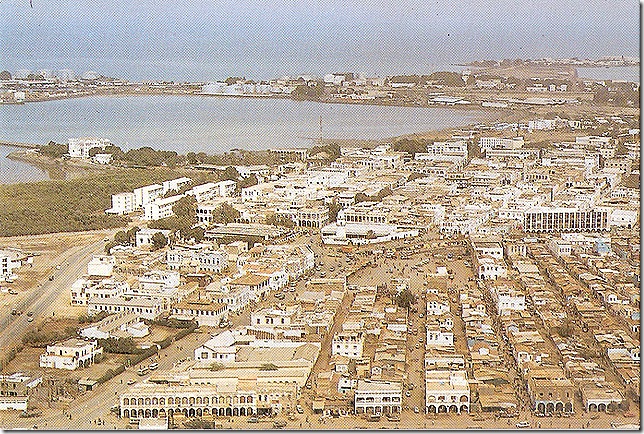Following on from my last post about Saigon, another postcard in the same series depicts Djibouti. Now, Djibouti is probably not high on most people’s ‘must see’ list. It didn’t, for example, get a mention in the ‘1,000 Places To See Before You Die’ travel book. It is not the sort of place which has much appeal to the readers of Conde Nast Traveler or Harper’s Bazaar. Unless you have an uncle in the French Foreign Legion or you have been hijacked by Somali pirates, you may not even have heard of it. In fact it was perhaps better known in the 1920s, when this postcard was made, than it is today. At least those days passenger liners used to stop there, French ones anyway (British ships would have stopped at nearby Aden instead).
So in case you are not too familiar with the place, the Republic of Djibouti is a tiny country of around 9000 square miles, wedged between Eritrea and Somalia on the shores of the Red Sea and Gulf of Aden. It also borders Ethiopia and there is a railway running from Addis Ababa to the city of Djibouti , providing Ethiopia with its only access to the sea since the latter’s relations with Eritrea are strained. The country was originally named French Somaliland, then became the Territoire Francais Des Afars Et Des Issas until changing to the current name in 1977 on achieving independence from France. Afars and Issas by the way are the names of the main ethnic groups living in the country. The Afars are traditionally nomadic herdsman with strong connections to Ethiopia while the Issas have Somali origins. With very limited economic potential of its own, the country has relied on economic assistance from France for much of its history, serving as a French military base. In more recent years Djibouti has also hosted a US military presence who are there to keep an eye on terrorist organizations who might be operating in neighbouring Somalia.
I had the pleasure of visiting Djibouti a number of times in the mid 1980s. I was working in Taiz in nearby North Yemen at the time and it was the practice for us guys to pop over to Djibouti for visa reasons and for rest and recreation. As you might be able to sense from the photo above, Djibouti was red hot, dusty and rather shabby but it seemed like a civilized holiday resort to me, compared to Yemen. I would visit a small French style supermarche and stock up with delicacies which I could not get in Taiz, which was most things but especially cheese and pork items. I would fly over from Yemen by Yemenia without a suitcase but with a cool box. The Yemeni customs officials would look suspiciously at the contents on return but they always let me through.
One of my favourite haunts was the Bar Restaurant Du Palmier en Zinc located on the central Place Menelik, where I would sit on the shady terrace sipping a citron presse and enjoying a jambon baguette. This bar, which was frequented by kepi-wearing military types and French civilians, was the target of a grenade attack in December 1977 killing 6 and wounding 32. Thankfully peace had been restored by the time of my visits though the arches of the restaurant were screened off with chicken wire to prevent projectiles from being lobbed inside.
Sadly it seems this building is no more. I gather from the internet that it has been demolished and replaced by a hideous concrete apartment block. At least they named the new building after the bar.



